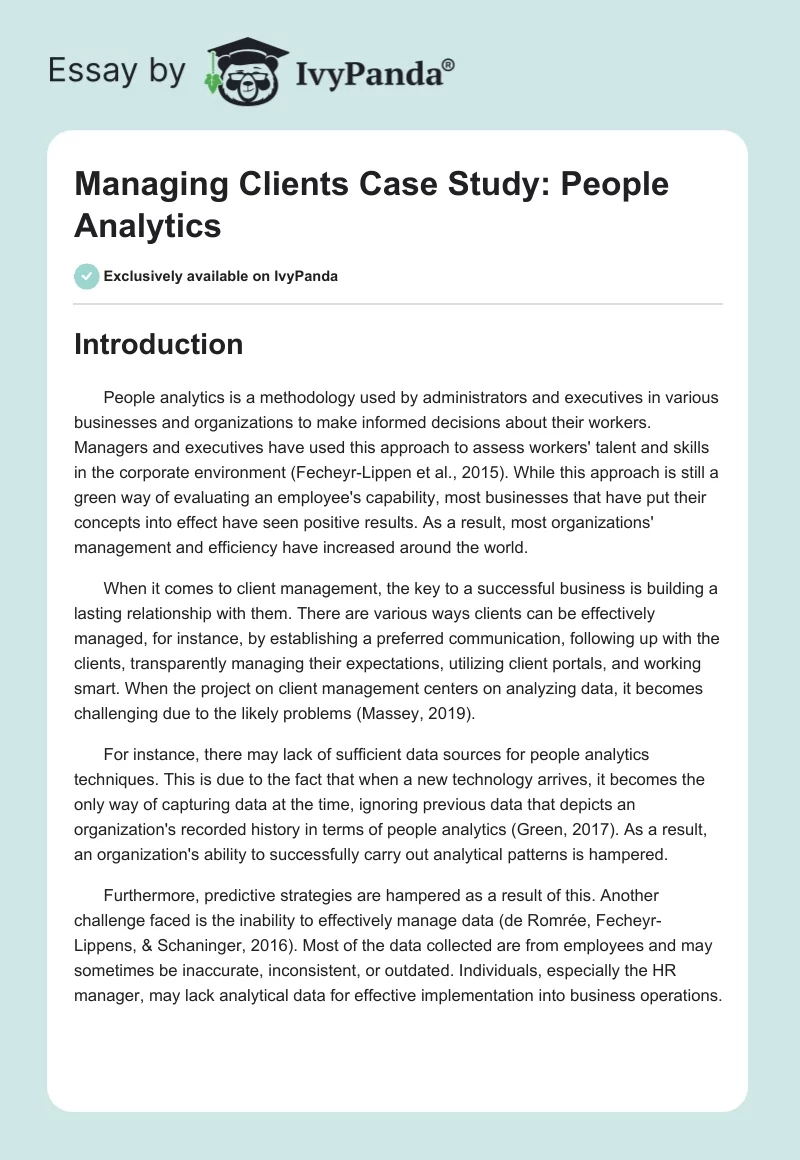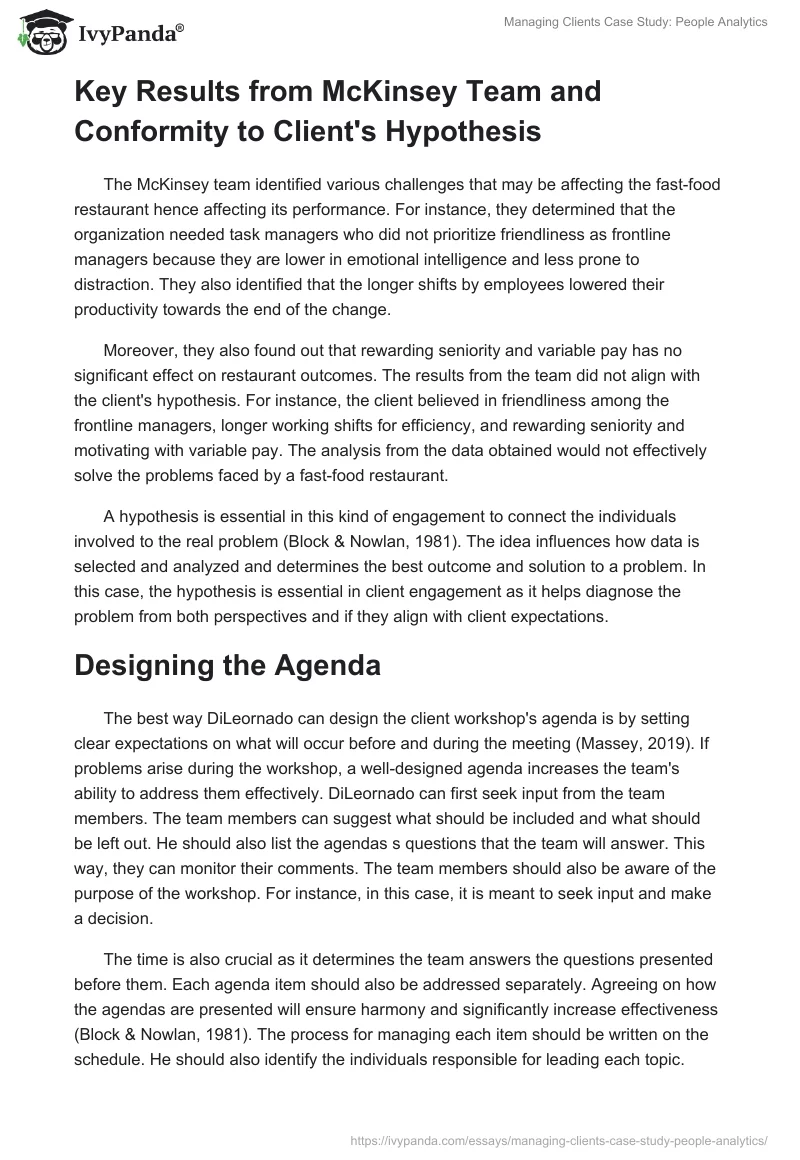Introduction
People analytics is a methodology used by administrators and executives in various businesses and organizations to make informed decisions about their workers. Managers and executives have used this approach to assess workers’ talent and skills in the corporate environment (Fecheyr-Lippen et al., 2015). While this approach is still a green way of evaluating an employee’s capability, most businesses that have put their concepts into effect have seen positive results. As a result, most organizations’ management and efficiency have increased around the world.
When it comes to client management, the key to a successful business is building a lasting relationship with them. There are various ways clients can be effectively managed, for instance, by establishing a preferred communication, following up with the clients, transparently managing their expectations, utilizing client portals, and working smart. When the project on client management centers on analyzing data, it becomes challenging due to the likely problems (Massey, 2019).
For instance, there may lack of sufficient data sources for people analytics techniques. This is due to the fact that when a new technology arrives, it becomes the only way of capturing data at the time, ignoring previous data that depicts an organization’s recorded history in terms of people analytics (Green, 2017). As a result, an organization’s ability to successfully carry out analytical patterns is hampered.
Furthermore, predictive strategies are hampered as a result of this. Another challenge faced is the inability to effectively manage data (de Romrée, Fecheyr-Lippens, & Schaninger, 2016). Most of the data collected are from employees and may sometimes be inaccurate, inconsistent, or outdated. Individuals, especially the HR manager, may lack analytical data for effective implementation into business operations.
Key Results from McKinsey Team and Conformity to Client’s Hypothesis
The McKinsey team identified various challenges that may be affecting the fast-food restaurant hence affecting its performance. For instance, they determined that the organization needed task managers who did not prioritize friendliness as frontline managers because they are lower in emotional intelligence and less prone to distraction. They also identified that the longer shifts by employees lowered their productivity towards the end of the change.
Moreover, they also found out that rewarding seniority and variable pay has no significant effect on restaurant outcomes. The results from the team did not align with the client’s hypothesis. For instance, the client believed in friendliness among the frontline managers, longer working shifts for efficiency, and rewarding seniority and motivating with variable pay. The analysis from the data obtained would not effectively solve the problems faced by a fast-food restaurant.
A hypothesis is essential in this kind of engagement to connect the individuals involved to the real problem (Block & Nowlan, 1981). The idea influences how data is selected and analyzed and determines the best outcome and solution to a problem. In this case, the hypothesis is essential in client engagement as it helps diagnose the problem from both perspectives and if they align with client expectations.
Designing the Agenda
The best way DiLeornado can design the client workshop’s agenda is by setting clear expectations on what will occur before and during the meeting (Massey, 2019). If problems arise during the workshop, a well-designed agenda increases the team’s ability to address them effectively. DiLeornado can first seek input from the team members. The team members can suggest what should be included and what should be left out. He should also list the agendas s questions that the team will answer. This way, they can monitor their comments. The team members should also be aware of the purpose of the workshop. For instance, in this case, it is meant to seek input and make a decision.
The time is also crucial as it determines the team answers the questions presented before them. Each agenda item should also be addressed separately. Agreeing on how the agendas are presented will ensure harmony and significantly increase effectiveness (Block & Nowlan, 1981). The process for managing each item should be written on the schedule. He should also identify the individuals responsible for leading each topic. Individuals may have organizational responsibility for different areas, and determining who is responsible for each site before the meeting will avoid many problems and confusion.
Challenges to be Anticipated
Due to the contradicting nature of the McKinsey team’s results with the Fast food restaurant organizational beliefs, some challenges are anticipated in the process. For instance, diLeornado may face resistance if the clients are not satisfied with the results generated by the team. Another challenge is poorly defined goals (Massey, 2019). The project manager and the team may not have come up with what they are supposed to deliver, and this can bring confusion, miscommunication, and miss important milestones for the success of the project. The tasks may also lack accurate description, and the team findings may also lack business value (de Romrée, Fecheyr-Lippens, & Schaninger, 2016). These can be solved by effectively designing the agenda and taking time to understand the problem before reaching out to the client.
References
Block, P., & Nowlan, J. (1981). Flawless consulting: A guide to getting your expertise used (p. 371). San Francisco, CA: Pfeiffer.
De Romrée, H., Fecheyr-Lippens, B., & Schaninger, B. (2016). People analytics reveals three things HR may be getting wrong. McKinsey Quarterly.
Fecheyr-Lippens, B., Schaninger, B., & Tanner, K. (2015). Power to the new people analytics.
Green, D. (2017). The best practices to excel at people analytics. Journal of Organizational Effectiveness: People and Performance, 4(2), 137-144.
Massey, C. (2019). How You Can Have More Impact as a People Analyst. MIT Sloan Management Review, 60(3), 19-21.


